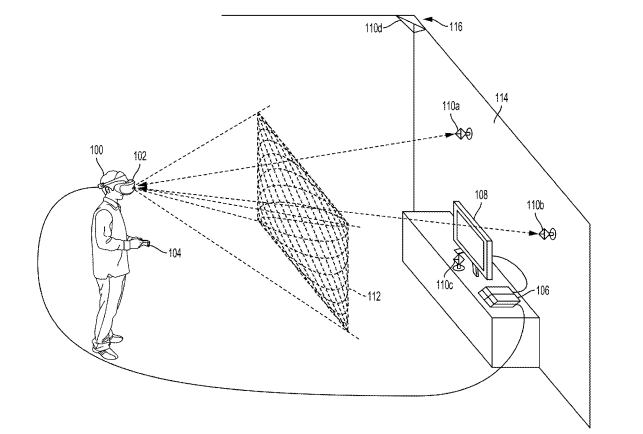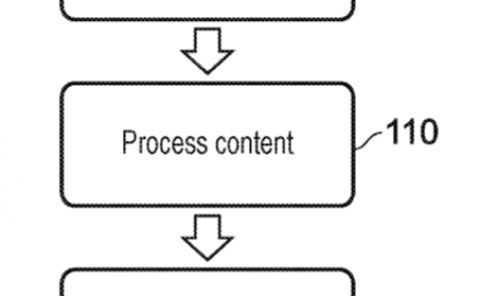Sony Patent | Head-Mounted Display Tracking Using Corner Reflectors
Patent: Head-Mounted Display Tracking Using Corner Reflectors
Publication Number: 20180364483
Publication Date: 2018-12-20
Applicants: Sony

Abstract
A head-mounted display (HMD) is provided, including the following: an emitter configured to emit a scanning beam into an interactive environment in which the HMD is disposed, the scanning beam being configured to continuously trace a predefined scan pattern; a detector configured to detect reflections of the scanning beam back to the HMD by each of a plurality of reflectors; a processor configured to, for each reflector, determine a time at which the reflection of the scanning beam by the reflector occurred, wherein the time is used to determine a location or orientation of the HMD in the interactive environment; a display device configured to render a view of a virtual space that is determined based on the determined location or orientation of the HMD.
Background
The video game industry has seen many changes over the years. As computing power has expanded, developers of video games have likewise created game software that takes advantage of these increases in computing power. To this end, video game developers have been coding games that incorporate sophisticated operations and mathematics to produce very detailed and engaging gaming experiences.
Example gaming platforms include the Sony Playstation.RTM., Sony Playstation2.RTM. (PS2), Sony Playstation3.RTM. (PS3), and Sony Playstation4.RTM. (PS4), each of which is sold in the form of a game console. As is well known, the game console is designed to connect to a display (typically a television) and enable user interaction through handheld controllers. The game console is designed with specialized processing hardware, including a CPU, a graphics synthesizer for processing intensive graphics operations, a vector unit for performing geometry transformations, and other glue hardware, firmware, and software. The game console may be further designed with an optical disc reader for receiving game discs for local play through the game console. Online gaming is also possible, where a user can interactively play against or with other users over the Internet. As game complexity continues to intrigue players, game and hardware manufacturers have continued to innovate to enable additional interactivity and computer programs.
A growing trend in the computer gaming industry is to develop games that increase the interaction between the user and the gaming system. One way of accomplishing a richer interactive experience is to use wireless game controllers whose movement is tracked by the gaming system in order to track the player’s movements and use these movements as inputs for the game. Generally speaking, gesture input refers to having an electronic device such as a computing system, video game console, smart appliance, etc., react to some gesture made by the player and captured by the electronic device.
Another way of accomplishing a more immersive interactive experience is to use a head-mounted display (HMD). A head-mounted display is worn by the user and can be configured to present various graphics, such as a view of a virtual space. The graphics presented on a head-mounted display can cover a large portion or even all of a user’s field of view. Hence, a head-mounted display can provide a visually immersive experience to the user.
A head-mounted display (HMD) provides an immersive virtual reality experience, as the HMD renders a three-dimensional real-time view of the virtual environment in a manner that is responsive to the user’s movements. The user wearing an HMD is afforded freedom of movement in all directions, and accordingly can be provided a view of the virtual environment in all directions via the HMD. The processing resources required to generate high quality video (e.g. at high resolution and frame rate) for rendering on the HMD are considerable and therefore typically handled by a separate computing device, such as a personal computer or a game console. The computing device generates the video for rendering to the HMD, and transmits the video to the HMD.
To provide a realistic viewing experience on an HMD, it is imperative to track the location and orientation of the HMD in the interactive environment with high levels of precision and responsiveness, so that the appropriate view of the virtual environment can be generated to for rendering through the HMD to provide a real-time viewing experience. To facilitate tracking of the HMD, current state-of-the-art HMD systems typically employ additional wired peripherals, such as emitters or sensors stationed at various locations in the local environment. These emitters or sensors must be connected to the central computing device by lengthy wires or cables that can be unsightly and difficult to manage. Coupled with the fact that additional cables are typically necessary for the HMD device itself, and such setups are cumbersome in terms of placement and connection of all of the different devices. The complexity of such setups further poses a barrier to the adoption and continued use of HMD systems.
Summary
Implementations of the present disclosure include devices, methods and systems relating to using corner reflectors for tracking a head-mounted display (HMD).
In some implementations, a head-mounted display (HMD) is provided, including the following: an emitter configured to emit a scanning beam into an interactive environment in which the HMD is disposed, the scanning beam being configured to continuously trace a predefined scan pattern; a detector configured to detect reflections of the scanning beam back to the HMD by each of a plurality of reflectors; a processor configured to, for each reflector, determine a time at which the reflection of the scanning beam by the reflector occurred, wherein the time is used to determine a location or orientation of the HMD in the interactive environment; a display device configured to render a view of a virtual space that is determined based on the determined location or orientation of the HMD.
In some implementations, the emitter includes a beam generator and a microelectromechanical system (MEMS) mirror, the beam generator configured to generate and direct the scanning beam towards the MEMS mirror, wherein the MEMS mirror is controlled to steer the scanning beam to continuously trace the predefined scan pattern.
In some implementations, the predefined scan pattern is defined by a raster scan pattern or a Lissajous scan pattern.
In some implementations, the scanning beam is defined by an infrared (IR) beam that is generated by the beam generator.
In some implementations, each of the plurality of reflectors is configured to reflect the scanning beam back to the HMD along a return path that is substantially parallel and substantially coincident to an emission path along which the scanning beam was emitted from the emitter.
In some implementations, each of the plurality of reflectors is defined by a corner reflector.
In some implementations, the detector includes at least one photosensor configured to detect the reflections of the scanning beam.
In some implementations, the plurality of reflectors includes three or more reflectors.
In some implementations, determining the location or orientation of the HMD includes, for each reflector, determining a position of the scanning beam at the time that the reflection of the scanning beam from the reflector occurred.
In some implementations, a system is provided, including the following: a plurality of reflectors; a head-mounted display (HMD), including, an emitter configured to emit a scanning beam into an interactive environment in which the HMD is disposed, the scanning beam being configured to continuously trace a predefined scan pattern; a detector configured to detect reflections of the scanning beam back to the HMD by each of a plurality of reflectors; a processor configured to, for each reflector, determine a time at which the reflection of the scanning beam by the reflector occurred, wherein the time is used to determine a location or orientation of the HMD in the interactive environment; a display device; a computing device, the computing device configured to generate a view of a virtual space that is determined based on the determined location or orientation of the HMD in the interactive environment; wherein the display device of the HMD is configured to render the view of the virtual space.
In some implementations, the emitter includes a beam generator and a microelectromechanical system (MEMS) mirror, the beam generator configured to generate and direct the scanning beam towards the MEMS mirror, wherein the MEMS mirror is controlled to steer the scanning beam to continuously trace the predefined scan pattern.
In some implementations, each of the plurality of reflectors is configured to reflect the scanning beam back to the HMD along a return path that is substantially parallel and substantially coincident to an emission path along which the scanning beam was emitted from the emitter.
In some implementations, each of the plurality of reflectors is defined by a corner reflector.
In some implementations, the detector includes at least one photosensor configured to detect the reflections of the scanning beam.
In some implementations, the plurality of reflectors includes three or more reflectors.
In some implementations, determining the location or orientation of the HMD includes, for each reflector, determining a position of the scanning beam at the time that the reflection of the scanning beam from the reflector occurred.
In some implementations, a method is provided, including the following operations: emitting, from a head-mounted display (HMD), a scanning beam into an interactive environment in which the HMD is disposed, the scanning beam being configured to continuously trace a predefined scan pattern; detecting, at the HMD, reflections of the scanning beam back to the HMD by each of a plurality of reflectors; for each reflector, determining a time at which the reflection of the scanning beam by the reflector occurred, wherein the time is used to determine a location or orientation of the HMD in the interactive environment; rendering through the HMD a view of a virtual space that is determined based on the determined location or orientation of the HMD.
In some implementations, the predefined scan pattern is defined by a raster scan pattern or a Lissajous scan pattern.
In some implementations, each of the plurality of reflectors is configured to reflect the scanning beam back to the HMD along a return path that is substantially parallel and substantially coincident to an emission path along which the scanning beam was emitted from the HMD.
In some implementations, each of the plurality of reflectors is defined by a corner reflector.
Other aspects and advantages of the disclosure will become apparent from the following detailed description, taken in conjunction with the accompanying drawings, illustrating by way of example the principles of the disclosure.


